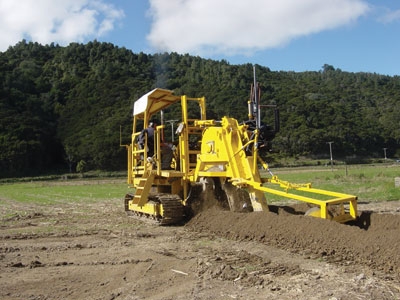
Features
Contractor at Work
Down time turning up opportunities
Necessity, and knowing what works best, makes practical sense.
November 13, 2012 By Jim Cody*
 I relied on my own experience and expertise to design my own trencher It was in a time when General Motors was about to fall over
I relied on my own experience and expertise to design my own trencher It was in a time when General Motors was about to fall overIt was in a time when General Motors was about to fall over, banks needed taxpayer money to keep them afloat, and my dairy farmer customers had taken a hit, as their income had dropped from $7.10 to $4.20 per kilogram of fat.
Three years of drought made it hard to sell drainage and a low New Zealand dollar made the opportunity of importing a new trencher from overseas out of the question.
So I set about using my down time and making a new machine to fit my needs.
About 50 percent of my work sees me back-filling the trench with pumice or metal, so cutting a 150-millimeter- (six inch) wide trench keeps costs a lot lower (five cubic meters per 100 meter of trench).
Getting older myself, the machine needed to be easy to get on and off, and to walk around. We also need to comply with high safety standards these days.
By unrolling the pipe up off the ground on a hydraulic-operated pipe reel, it stops the pipe getting caught on stubble.
When making the trencher I needed, I made it with parts designed by firms that will be around in the future, with the likes of a 180-horsepower Cummins engine, Komatsu tracks and Sunstand pumps and gearbox. There were also 63-cubic-centimeter tandem pumps for the track drive, a 120-cubic-centimeter pump on the chain drive and a 1200 cubic centimeter SAI hydraulic motor.
A 100-millimeter pinch digging chain purchased through Mastenbroek in England, keeps things standard and works out well. The engine, pumps, gearbox, bonnet – in fact, the whole power pack – is made on its own sub-frame and sits inside the main chassis rails; just undo four bolts and some hoses, and anyone can lift the lot out.
One thing I have noticed when cutting a narrow trench: there is a big increase in digging chain life over a wider cut.
I am a great believer that the best way to make trenchers grade naturally is to use a lift mast, mounted a third of the way down and inside the track frames, with the top rams in float.
Having the main frame with auto level keeps the lift mast straight up and down on the cross axis, and is assenting, plus the use of the pivot inside the mast takes the stress off of the digger main frame. When digging around bends, the design makes it easy to keep the trench straight.
Refuelling the 400-liter tank and checking engine fluids are made a lot easier by being in one location, and having an easy-lift bonnet and footsteps make life simpler still.
Doing maintenance on the digging chain is also made easier by having an access door that opens up to the top drive sprocket, with an added advantage of having a walkway to stand on. A grease-gun-operated digging chain tension makes maintenance quicker and also helps the chain life. The ladder makes getting on and off the machine easy, and tips up and over centre to keep safely out of the way.
By having a hydraulically operated walk ramp, it is both easy and safe to walk out from the operator’s seating area to feed the pipe into the chute when making starts, and adjusting the height of the Australian-made laser control system that I have used for around 15 years on my other machines.
Keeping the weight down to around seven tons, the width to 2.2-meters and overall length to nine meters – not to mention making it well balanced, makes the machine easy – to use in confined areas, such as a Kiwi fruit orchard.
The trencher has a maximum working depth of 1.9 meters.
The only thing that has not lived up to my expectations is the sunroof, I am not sure how to improve it and keep the machine easy to handle.
To date I have trenched around 190 kilometers using this machine and all is well; the balance of horsepower to speed and weight is right.
In the last 10 months, we have had around 2.5 meters of rain, being a farm drainage contractor, I only get wet farms to drain, and too wet to work does slow down the cash flow.
The dairy farmers are now getting around $7.80 per kilogram of butter fat, but the Kiwi fruit orchards have been hit by the PSA (pseudomonas syringae pv actinidae) disease, and we’re not sure what that means yet.
After building this machine, I can say I have learned a lot, and if doing it again I would do a few things differently. If I put my businessman’s hat on, I think I would have bought a drainage plow machine off the shelf, just not sure how I would pay for it. This being my 31st year in business in Whakatane as a farm drainage tiling contractor, it is hoped this trencher should see me out.
*Jim Cody is a drainage contractor from Whakatane, New Zealand.
Print this page